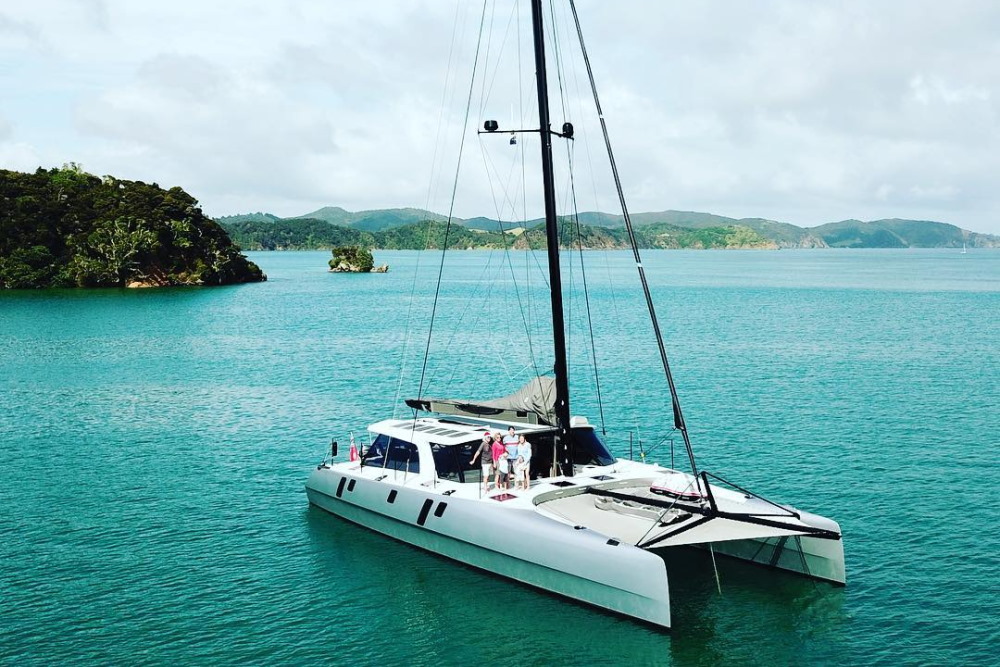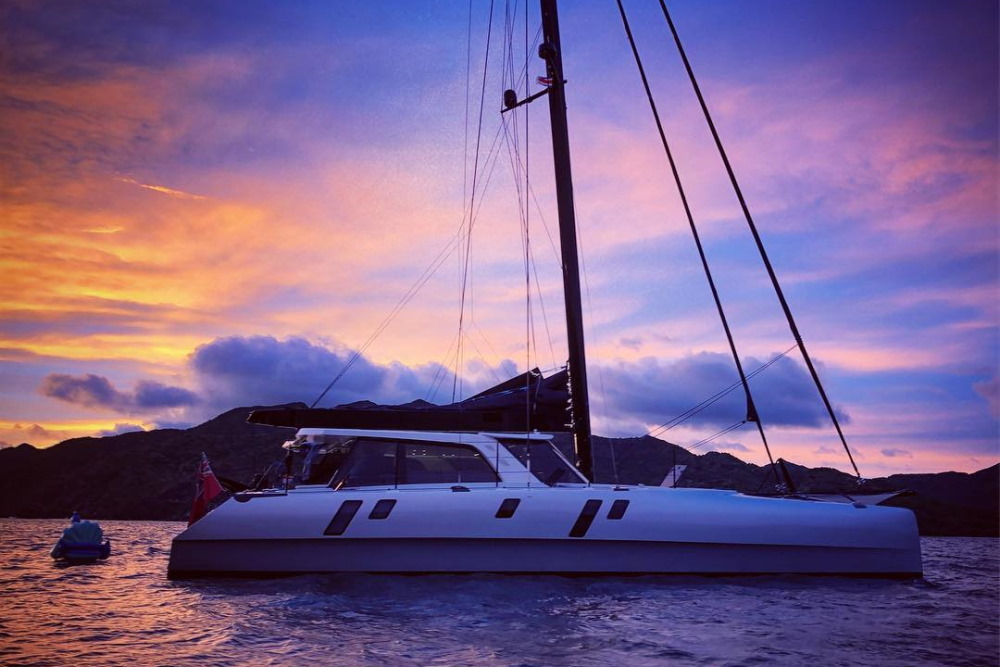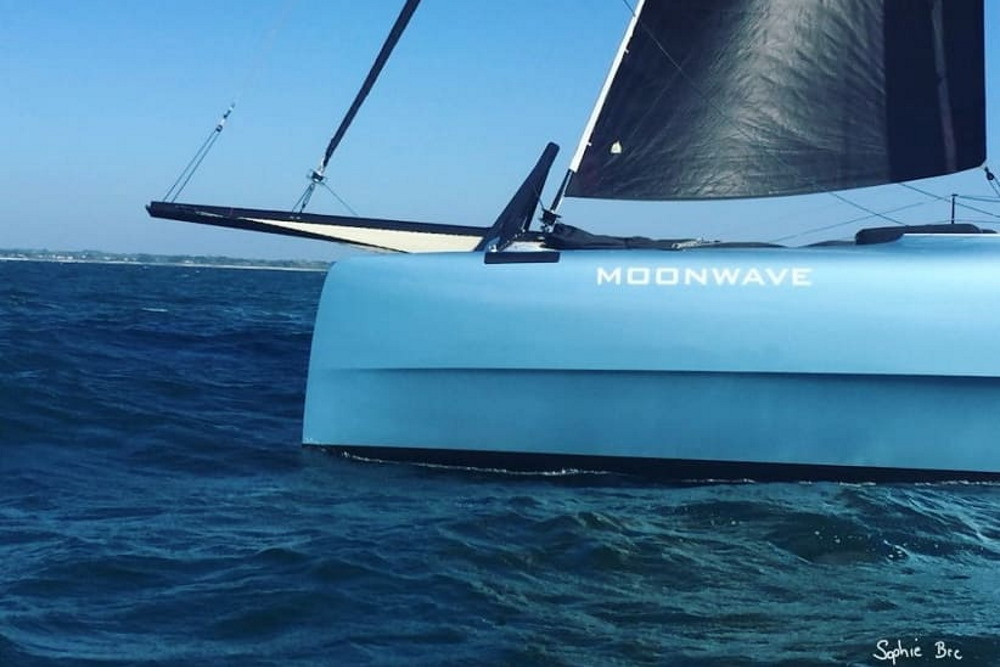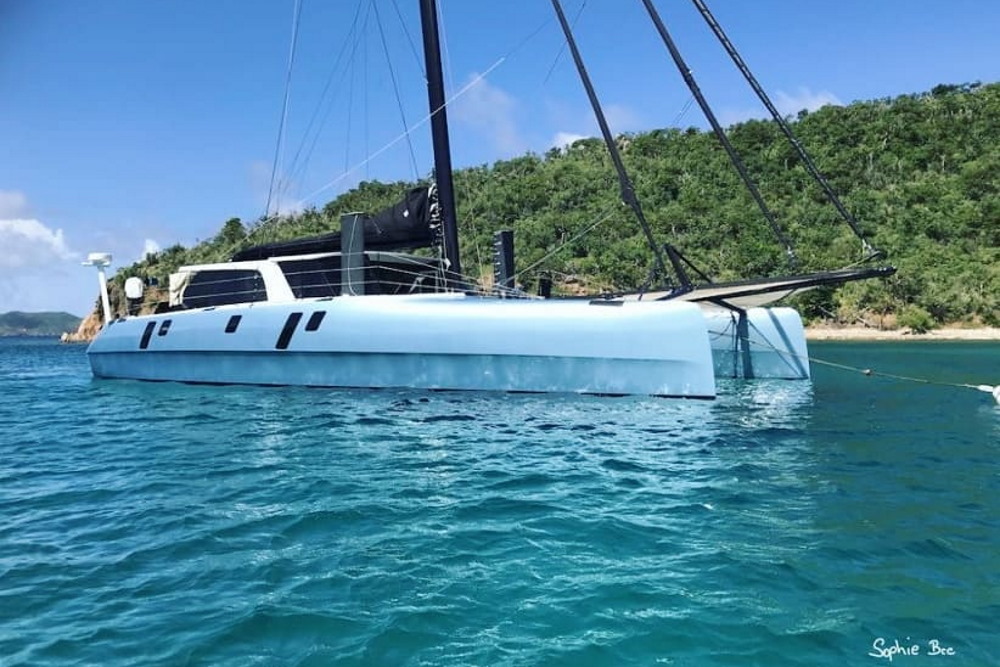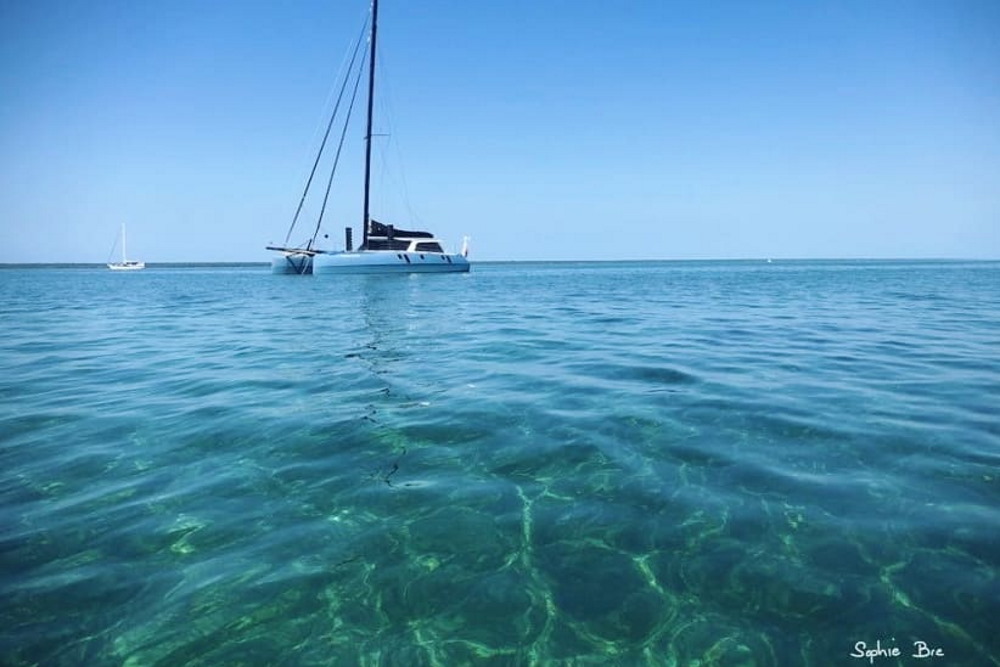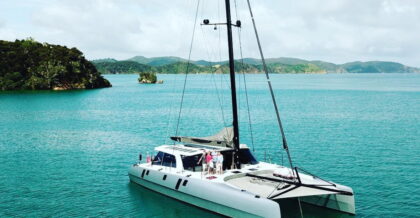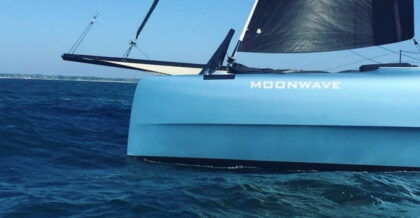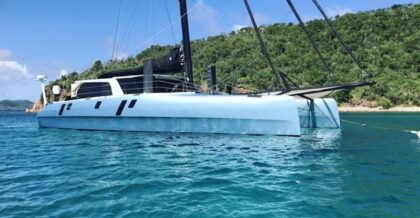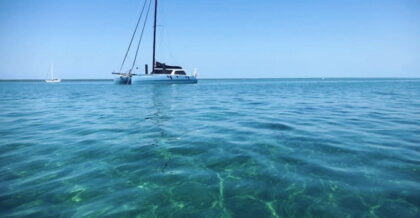Following a range of successful models that were designed by Morrelli & Melvin (the original 62, then the 48 and the Gunboat 66), Peter Johnstone, the original Gunboat founder before Grand Large Yachting days, turned to British record breaking yacht Designer Nigel Irens for the next cat to come out of the GB bag: the Gunboat 60.
This design was quite an evolutionary step for the famous marque, with a more curvaceous look, a hull chine, axe bows and big near vertical wrap around windows for 360 degree views. 60 foot is the sweet spot for a smooth ride, plenty of living space and 300+ miles daily passages in good conditions. Not many boats can pull off those kinds of miles in the day. The O-Yachts Class 6 catamaran comes to mind, and HH catamarans, but Gunboat was bossing this market segment first.
Photo credit Instagram: @oliver_bzh, @_a_l_a_i_a_, @sophie_bre_voyage
Sailing
This is the key section for Gunboat owners isn’t it? Gunboats are all about speed, and Nigel Irens doesn’t disappoint with his Gunboat 60 design. You will be sailing at true wind speed and even over in lighter airs and she pinches close to the wind if needed (40 degrees TWA is not an issue on these boats). If you have spent this kind of money on a boat, the chances are that you will have a full sail locker with a Code 0 to do the work upwind in lighter airs and a Gennaker to fly off the wind, not to mention a range of sails inbetween.
When the breeze fills in, you will comfortably hitting double digits in knots and sailed to her full potential she will sit in the twenties, but you will need to be alert and on your toes. 300-mile days are your target in good conditions. This is the kind of performance that has inspired other manufacturers such as Balance Catamarans and Kinetic to name a few.
The Gunboat record is over 400.
And there are plenty of safety features on the 60 to help you manage all of this power. Digital load sensors monitor the stresses on the rig in real time and, if you are not the kind of sailor who relishes flying a hull in a multi-million dollar yacht, you can program the system to automatically release the sheets on the mainsheet and the headsail when rig loads hits a limit.
Even so, the Gunboat 60 is not designed to be sailed by a novice. You will need some serious miles under your belt before you slip into the helm seat, or employ a seasoned captain
Build
As with all Gunboats, the construction was high end racing yacht quality. The hull laminate is carbon fiber set in epoxy resin, fully infused and post-cured over a CoreCell foam core. All the fittings and components inside are foam-cored and skinned with wood veneers to keep the weight off and the look luxurious. The rig is carbon with a Marstrom rotating wing-section mast and aramid fiber rigging. All the Furling gear was sourced from Facnor.
One big design change from previous models was the installation of carbon centerboards instead of daggerboards. This makes for a safer structure along with carbon retractable rudders, which are retractable. The centerboards are operated with by hydraulic rams and fitted with shear pins that allow the boards to kick up in the event of a grounding.
The narrow hulls slice through the water and she sports a high bridgedeck, and nothing forward of the mast except the nets and a long carbon bowsprit. The hulls and bridgedeck are constructed in one mold, and there is no forward beam.
On Deck
The Gunboat 60 is set up with the forward cockpit that has proven so popular with owners: just behind the mast and forward of the saloon. , All working lines come into this space and are managed by a set of three Lewmar winches. She’s set up to sail with a short handed crew. You helm on one of two Edson carbon wheels : one outside and one inside. Take your pick according to the conditions and weather.
From the Saloon wheel, you can see the headsail telltales and the mainsail above through two deck hatches. The mainsheet is managed from here or dumped with a big safety one button if you feel the boat starting to become overpowered. The nav station is tucked neatly forward on the starboard side with a plotter and autopilot in front of the wheel as well.
Behind the helm position, the cockpit opens aft into a large, comfortable, open space with sofas, tables, and a window through to the galley on the port side. There’s an electric barbecue aft.
Down Below
Despite the fact that this is a 60 foot boat, the living accommodation is not huge (there’s a trade off for all of that speed), but it is hardly cramped either and luxuriously fitted. The layout is normally four double-berth staterooms, plus a crew cabin forward to port with two single berths. This space is sometimes configured as an office or workspace. The berths in the midship staterooms are athwartships, and aft, the berths are smaller and run along the hulls. There is plenty of light down below through hull ports and deck hatches.
Large, near vertical windows enclose the saloon, with the galley to port and dining area to starboard. Once you have the two windows and all of the doors open at anchor, the breeze flows though – one of the defining designs of most Gunboats. There’s plenty of working space in the galley with all of the mod cons that you’d expect on a luxury performance catamaran.
Power
Many Gunboat 60s were designed to leave a small footprint when under power with a hybrid propulsion system. Optional electric motors turn the propellers on retractable sail drive legs powered by a large lithium-ion battery pack. These are charged by solar and the props when you are sailing. There are a pair of generators for backup.
Many of the Gunboat 60s, such as Moonwave, have further developed the power system over the years.
The boat motors up to 9 knots for around half an hour before the generators kick in. If you are just using the engines to get in and out of marinas, you will have considerably longer on battery power alone. The idea, of course, is to get the sails up as quick as possible. In anything over 4 knots of wind, you should be sailing.
Fast Boat to China
In a bid to reduce manufacturing costs, Peter Johnstone moved production of the Gunboats from South Africa to Hudson Marine in China. The relationship turned sour following multiple warranty claims on the boats, which were mostly do do with the new centreboard design. Johnstone accused Hudson Wang of sub standard manufacturing quality, and Wang counter sued claiming that the problem was with the original design. It is not unheard of to go through these issues with new boat designs, especially at this kind of high tech level. The problems were eventually resolved, but the damage was gone and the 2 parties fell out over the issue.
Johnstone moved production for his next model, the 55, to the US and later ran into financial difficulties while Hudson Wang ended up launching a performance catamaran brand of his own.
Gunboat 60s – Where Are They Now?
60-01 Defiance (ex Fault Tolerant, ex Golden Gun)
Follow them on Instagram on @sailingdefiance
60-02 Flow
Flow caught on fire in Badalona near Barcelona in May 2023 and was written off. Not good news.
60-03 Moonwave
Moonwave has been lavished with upgrades since her launch including a new power unit.
Head to Moonwave.com or check out our Moonwave Gunboat article
60-04 Alaia (ex Jade)
You can follow Alaia on alaia60.com and on social media.
60-05. Prana
(launched before Jade)
60-06. Arethusa
60-07
Never completed?
60-08 Momentum
FAQs
How Much Does a Gunboat 60 cost? What is the Price Ticket?
Gunboat 60s are no longer in production, so you will need to buy second hand to get your hands on one. There aren’t many, and they hold their price, as do most Gunboats. When they were launched, the list price was around $2.5m. You’ll still likely pay up to $2m for one today.
What Happened Between Gunboat and Hudson Marine?
Gunboat International, the North Carolina yard, sued the Chinese yard accusing the builder of not finishing the build properly on the Gunboat 60s and that the yard refused to pay warranty claims on constructed yachts they claimed weren’t built properly. Hudson Yacht and Marine Industries denied the allegations and then countersued Gunboat, saying that design flaws, not builder error, led to the warranty claims and that it was not contractually obliged to fix mistakes that were a result of the design. In the end Gunboat picked up the repair tab (some $10m) and then tried to terminate the contract with HYM. However, the Chinese yard refused to return the molds and tooling, according to Peter Johnstone. Johnstone then accused the company and its owner, Hudson Wang, of launching a “knockoff brand” of carbon fiber performance catamarans onto the market despite signing a non-compete contract.
What Was the Cause of the Dispute?
Most of the problems came from the centreboard design, which was new to the market at the time. There were also problems with the hydraulic propeller system (or “skeg system”). Gunboat also accused Hudson of “deliberately, willfully and maliciously obtaining Gunboat’s trade secrets with the intention of utilizing said trade secrets in connection with, and incorporating them into, the competing HH Catamaran 55 and 66 series, and HYM and Wang did, in fact, appropriate and utilize said trade secrets for their own benefit and profit.”
Safe to say that this is all water under the bridge now. The Gunboat brand was sold to Grand Large Yachting who now manufacture the 68, a completely different design developed by VPLP. And yes, HH still market the 55 and 66, 2 boats designed by Morrelli and Melvin who designed the earlier Gunboats. It’s a small sailing world.
Technical Specification
| Disp. (Light) | 15,500 Kg / 34,172 lbs |
|---|---|
| D/L | 71 |
| SA/D | 34 |
| Water | 2 x 380 L / 2 x 100gal |
| Fuel | 2 x 380 L / 2 x 100gal |
| Draft (Boards up) | 0.8m / 2.6' |
| Draft (Boards Down) | 2.8m / 9.2' |
| Beam | 8.6m / 28.2' |
| SA/D* | 34 |
| Length WL | 18.25m / 59.75' |
| Disp. Max | 19,500 Kg / 42,990 lbs |
| Sail Area (Upwind) | 208 m2 / 2239 sq ft |
| Length OA | 18.28m / 60' |
| Mast height (ASL) | 26m / 85.4' |
| Sail area upwind | 400 m2 / 4305 sq ft |
| Power example | 2 x 25 KW |
Contact Katamarans
Share your details with us and we’ll be in touch to discuss further.
"*" indicates required fields

